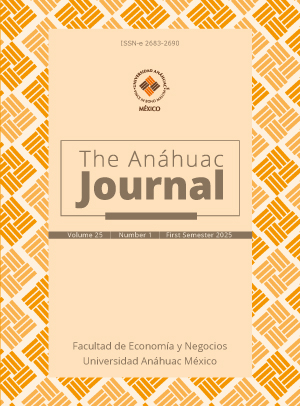Financial Inclusion of Business Owners Who Survived the COVID-19 Pandemic in Guadalajara, Monterrey, and Mexico City
Main Article Content
Abstract
This paper analyzes the marginal effect of different socioeconomic variables on the conditional probability that a business owner presents some degree of financial inclusion. A face-to-face survey with business owners who survived COVID-19 in Guadalajara, Monterrey, and Mexico City—including their metropolitan areas—was used as a source of information. The sample size consists of 1217 interviews applied in the year 2023. Linear probability, logit, probit, and robit models were used to establish a comparative framework for the results. The findings allow us to suggest strategies to promote financial inclusion of business owners in Mexico.
Downloads
PLUMX Metrics
Article Details

This work is licensed under a Creative Commons Attribution-NonCommercial-ShareAlike 4.0 International License.
This work is licensed under a Creative Commons Atribución-NoComercial-CompartirIgual 4.0 Internacional.
References
Ayyagari, M., Juarros, P., Martínez Peria, M. S., & Singh, S. (2016). Access to Finance and Job Growth: Firm-Level Evidence Across Developing Countries (Working Pa- per, 7604). World Bank Policy Research Working Document. https://documents1.worldbank.org/curated/en/804781467990954208/pdf/WPS7604.pdf
Comisión Nacional Bancaria y de Valores (CNBV). (2024). Portafolio de información. https://www.cnbv.gob.mx/Paginas/PortafolioDeInformacion.aspx
Cipoletta, G., & Matos, A. (2018). Hechos estilizados sobre la inclusión financiera en América Latina. In Pérez Caldente. E., & Titelman, D. (Eds.). La inclusión financi- era para la inserción productiva y el papel de la banca de desarrollo. (pp. 37-58). Comisión Económica para América Latina y el Caribe (Cepal). https://hdl.handle.net/11362/44227
Demirgüç-Kunt, A., Klapper, L., Singer, D., Ansar, S., & Hess, J. (2018). The Global Findex, Measuring Financial Inclusion and the Fintech Revolution. World Bank Group. https://documents1.worldbank.org/curated/en/332881525873182837/pdf/126033-PUB-PUBLIC-pubdate-4-19-2018.pdf
Gaxiola, S., Beltrán, J.H., and Mata, L. (2019). Estimating a Municipal Index of Finan- cial Inclusion for Mexico. Economic Challenger, 22(85), 23-34. https://tinyurl.com/24ssdspf
Gaxiola, S., Mata, L. & Valenzuela, P. (2020). Análisis de la inclusión financiera: opor- tunidades para el desarrollo del sector financiero mexicano. Panorama Económi- co, 16(31), 215-232. https://doi.org/10.29201/peipn.v16i31.31
Góngora Jiménez, S.R, Banda Ortíz, H., & Vivanco Vargas, M. (2023). Impacto de la inclusión financiera en el crecimiento económico en México por entidad federa- tiva 2013-2021. Revista Mexicana de Economía y Finanzas. Nueva Época (REMEF), 18(3), e891. https://doi.org/10.21919/remef.v18i3.891
Greene, W. H. (2010). Econometric analysis (4th ed). International edition. Prentice Hall.
Instituto Nacional de Estadística y Geografía (Inegi). (2021). Encuesta Nacional de Financiamiento de las Empresas (ENAFIN) 2021. https://www.inegi.org.mx/pro-gramas/enafin/2021/
Instituto Nacional de Estadística y Geografía (Inegi). (2023). Demografía de los nego- cios. https://www.inegi.org.mx/temas/dn/
Lara Álvarez, J. (2022). Inclusión financiera en México: impacto del acceso al finan- ciamiento a través de FIRA en los ingresos por ventas de las empresas. Reali- dad, Datos y Espacio. Revista Internacional de Estadística y Geografía, 13(1), 5-17. https://rde.inegi.org.mx/wp-content/uploads/2022/pdf/RDE36/RDE36_art1.pdf
Liu, C. (2004). Robit regression: a Simple Robust Alternative to Logistic and Probit Regression. In Gelman, A., & Meng, X. (Eds.). Applied Bayesian Modeling and Casual Inference from Incomplete-Data Perspectives (pp. 227-238). https://doi.org/10.1002/0470090456.ch21
López Rodríguez, P. (2021). La brecha de género en la inclusión financiera en México (Documento de trabajo 09/2021). Documento de Trabajo del Centro de Estudios Espinoza-Yglesias (CEEY). https://ceey.org.mx/la-brecha-de-genero-en-la-inclu-sion-financiera-en-mexico/
Naghi, A.A., Váradi, M., & Zhelonkin, M. (2022). Robust Estimation of Probit Mod- els with Endogeneity. Econometrics and Statistics, 34, 78-90. https://doi.org/10.1016/j.ecosta.2022.05.001
Organization for Economic Cooperation and Development (OECD). (2018). OECD Economic Outlook, 2018 (1), OECD Publishing. https://doi.org/10.1787/eco_out-look-v2018-1-en
Ortiz-Gregorio, A., Sauza-Ávila, B., Cruz-Domínguez, J.M., Lechuga-Canto, C.B., Pérez- Castañeda, S.S., & Cruz-Ramírez, D. (2023). La inclusión financiera en microempre- sarias mexicanas. Ingenio y Conciencia, Boletín Científico de la Escuela Superior Ciudad Sahagún 10 (20), 21-36. https://doi.org/10.29057/escs.v10i20.10772
Peña, X., Hoyo, C., & Tuesta, D. (2014). Determinants of Financial Inclusion in Mexico Based on the ENIF 2012. (Working Paper,14/15). BBVA Research Working Paper. https://www.bbvaresearch.com/wp-content/uploads/2014/06/WP_1415.pdf
Pérez-Akaki, P., & Fonseca, M.R. (2017). Análisis espacial de la inclusión financiera y su relación con el nivel de pobreza en los municipios mexicanos. Revista Mexicana de Economía y Finanzas. Nueva Época (REMEF), 12(1). https://doi.org/10.21919/remef.v12i1.13
Perez-Truglia, R. (2009). Applied Econometrics Using Stata [Unpublished manu- script]. https://www.studocu.com/row/document/addis-ababa-university/english/books-3316-0-read-it/87491729
Roa, M. J., & Carvallo, O. A. (2018). Inclusión financiera y el costo del uso de instru- mentos financieros formales: las experiencias de América Latina y el Caribe. https://tinyurl.com/4uyvpx6s
Salazar Cantú, J.D.J., Rodríguez Guajardo, R.C., & Jaramillo Garza, J. (2017). In- clusión financiera y cohesión social en los municipios de México. Revista Mexi- cana de Economía y Finanzas. Nueva Época (REMEF), 12(3), 45-66. https://doi.org/10.21919/remef.v12i3.96
Trejo García, J.C., Ríos Bolívar, H., & Soto Rosales, M.D.L. (2024). Inclusión financiera en México, un análisis mediante autocorrelación espacial y técnica de clustering.
Revista Mexicana de Economía y Finanzas. Nueva época (REMEF), 19(2), e844. https://doi.org/10.21919/remef.v19i2.844
White, H. (1980). A Heteroskedasticity-Consistent Covariance Matrix Estimator and a Direct Test for Heteroskedasticity. Econometrica: Journal of the Econometric Society, 817-838. https://www.jstor.org/stable/1912934
Wooldridge, J. M. (2010). Econometric Analysis of Cross Section and Panel Data. MIT Press. https://tinyurl.com/yzt9wrsb
Zulaica Piñeyro, C.M. (2013). Financial Inclusion Index: Proposal of a Multidimension- al Measure for Mexico. Revista Mexicana de Economía y Finanzas. Nueva Época (REMEF), 8(2), 157-180. https://doi.org/10.21919/remef.v8i2.46

